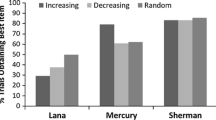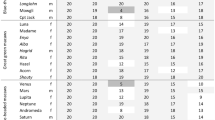Abstract
Chimpanzees (Pan troglodytes) frequently participate in social exchange involving multiple goods and services of variable value, yet they have not been tested in a formalized situation to see whether they can barter using multiple tokens and rewards. We set up a simple barter economy with two tokens and two associated rewards and tested chimpanzees on their ability to obtain rewards by returning the matching token in situations in which their access to tokens was unlimited or limited. Chimpanzees easily learned to associate value with the tokens, as expected, and did barter, but followed a simple strategy of favoring the higher-value token, regardless of the reward proffered, instead of a more complex but more effective strategy of returning the token that matched the reward. This response is similar to that shown by capuchin monkeys in our previous study. We speculate that this response, while not ideal, may be sufficient to allow for stability of the social exchange system in these primates, and that the importance of social barter to both species may have led to this convergence of strategies.



Similar content being viewed by others
References
Anderson JR (1996) Chimpanzees and capuchin monkeys: comparative cognition. In: Russon A, Bard K, Parker S (eds) Reaching into thought: the minds of the great apes. Cambridge University Press, Cambridge, pp 2–47
Boyd R (1992) The evolution of reciprocity when conditions vary. In: Harcourt A, de Waal FBM (eds) Coalitions and alliances in humans and other animals. Oxford University Press, Oxford, pp 493–489
Brosnan SF, de Waal FBM (2004) A concept of value during experimental exchange in brown capuchin monkeys. Folia Primatol 75:317–330
Chalmeau R (1994) Do chimpanzees cooperate in a learning task?. Primates 35:385–392
Chalmeau R, Gallo A (1996) What chimpanzees (Pan troglodytes) learn in a cooperative task. Primates 37:39–47
Chalmeau R, Visalberghi E, Gallo A (1997) Capuchin monkeys (Cebus apella) fail to understand a cooperative task. Anim Behav 54:1215–1225
Cowles JT (1937) Food-tokens as incentives for learning by chimpanzees. Comp Psychol Monogr 14(5):1–96
Custance D, Whiten A, Bard KA (1995) Can young chimpanzees (Pan troglodytes) imitate arbitrary actions? Hayes & Hayes (1952) revisited. Behaviour 132:837–859
Custance D, Whiten A, Fredman T (1999) Social learning of an artificial fruit task in capuchin monkeys (Cebus apella). J Comp Psychol 113:13–23
Daniel WW (1995) Biostatistics: a foundation for analysis in the health sciences, 6th edn. Wiley, New York
di Bitetti MS (1997) Evidence for an important social role of allogrooming in a platyrrhine primate. Anim Behav 54:199–211
Dube WV, McIlvane WJ (1993) The search for stimulus equivalence in nonverbal organisms. Psychol Rec 43:761–779
Dugdale N, Lowe CF (2000) Testing for symmetry in the conditional discriminations of language-trained chimpanzees. J Exp Anal Behav 73:5–22
Hyatt CW, Hopkins WD (1998) Interspecies object exchange: bartering in apes? Behav Process 42:177–187
Jorgensen MJ, Suomi SJ, Hopkins WD (1995) Using a computerized testing system to investigate the preconceptual self in nonhuman primates. In: Rochat P (ed) The self in infancy: theory and research. Elsevier, Amsterdam, pp 243–256
Limongelli L, Boysen ST, Visalberghi E (1995) Comprehension of cause and effecti relationships in a tool-using task by common chimpanzees (Pan troglodytes). J Comp Psychol 109:18–26
Mendres KA, de Waal FB M (2000) Capuchins do cooperate: the advantage of an intuitive task. Anim Behav 60(4):523–529
Mundry R, Fischer J (1998) Use of statistical programs for nonparametric tests of small samples often leads to incorrect P values: examples from Animal Behaviour. Anim Behav 56:256–259
Nissen HW, Crawford MP (1936) A preliminary study of food-sharing behavior in young chimpanzees. J Comp Psychol 22:383–419
Packer C (1988) Constraints on the evolution of reciprocity: lessons from cooperative hunting. Ethol Sociobiol 9:137–147
Paquette D (1992) Object exchange between captive chimpanzees: a case report. Hum Evol 7(3):11–15
Savage-Rumbaugh ES, Rumbaugh DM, Boysen S (1978) Linguistically mediated tool use and exchange by chimpanzees (Pan troglodytes). Behav Brain Sci 4:539–554
Seyfarth RM, Cheney DL (1988) Empirical tests of reciprocity theory: problems in assessment. Ethol Sociobiol 9:181–187
Sousa C, Matsuzawa T (2001) The use of tokens as rewards and tools by chimpanzees (Pan troglodytes). Anim Cogn 4:213–221
Tomasello M, Call J (1994) Social cognition of monkeys and apes. Yearb Phys Anthropol 37:273–305
Tomasello M, Call J (1997) Primate cognition. Oxford University Press, New York
Visalberghi E (1997) Success and understanding in cognitive tasks: a comparison between Cebus apella and Pan troglodytes. Int J Primatol 18:811–830
Visalberghi E, Limongelli L (1996) Action and understanding: tool use revisited through the mind of capuchin monkeys. In: Russon A, Bard K, Parker S (eds) Reaching into thought: the minds of the great apes. Cambridge University Press, Cambridge, pp 57–79
de Waal FBM (1982) Chimpanzee politics: power and sex among apes. The Johns Hopkins University Press, Baltimore
de Waal FBM (1989) Food sharing and reciprocal obligations among chimpanzees. J Hum Evol 18:433–459
de Waal FBM (1997a) The chimpanzee’s service economy: food for grooming. Evol Hum Behav 18:375–386
de Waal FBM (1997b) Food transfers through mesh in brown capuchins. J Comp Psychol 111:370–378
Whiten A, Custance DM, Gomez J-C, Teixidor P, Bard KA (1996) Imitative learning of artificial fruit processing in children (Homo sapiens) and chimpanzees (Pan troglodytes). J Comp Psychol 110:3–14
Wolfe JB (1936) Effectiveness of token-rewards for chimpanzees. Comp Psychol Monogr 12:1–72
Yamamoto J, Asano T (1995) Stimulus equivalence in a chimpanzee (Pan troglodytes). Psychol Rec 45:3–22
Acknowledgments
This research was made possible by an NSF Graduate Research Fellowship to the first author and the NIH basegrant (RR-00165) to the Yerkes National Primate Research Center. We are grateful to Rebecca Singer and Hillary Schiff for assistance with testing and data collection, Julian Bragg for assistance with the calculation of expected frequencies (Appendix), Ryan Earley for statistical advice, and two anonymous reviewers for helpful comments on an earlier draft of this manuscript. We also thank the animal care and veterinary staff for maintaining the health of our study subjects. The Yerkes Primate Center is fully accredited by the American Association for Accreditation of Laboratory Animal Care.
Author information
Authors and Affiliations
Corresponding author
Appendix 1: Calculations for determining expected frequency of reward returns
Appendix 1: Calculations for determining expected frequency of reward returns
There are twenty ways to randomly arrange three high-value rewards and three low-value rewards in a series of six trials. These can be divided into four basic classes.
-
Three high-value rewards followed by three low-value rewards (one possibility)
-
Two high-value rewards and one low-value reward in the first three trials, followed by one high-value reward and two low value rewards in the second three trials (nine possibilities)
-
One high-value reward and two low-value rewards in the first three trials, followed by two high-value rewards and one low-value reward in the second three trials (nine possibilities)
-
Three low-value rewards followed by three high-value rewards (one possibility)
If the arrangements of the trials is truly random, each possibility is equally likely, making it nine times more likely that a series will fall into the second or third class than into the first or fourth. By calculating the return generated by a particular strategy in each class of trial, multiplying those returns by the probability of encountering each class, and adding the products, we can calculate the expected return of that strategy under these conditions.
An individual pursuing the matching strategy will receive three high-value rewards and three low-value rewards from any of these trials, yielding an expected return of three high-value rewards and three low value rewards.
An individual pursuing the high value strategy with limited tokens will return the high-value tokens followed by the low-value tokens, with a total return ranging from three high-value rewards and three low-value rewards to no reward at all. The expected return is 1.5 high-value rewards and 1.5 low-value rewards.
An individual pursuing the high value strategy with unlimited tokens will return high-value tokens for every trial. The expected return is three high-value rewards.
An individual pursuing random strategy will return tokens with no regard to their value. For any given series of trials with limited tokens, there is a 1/20 chance that the individual will match the trials perfectly, a 9/20 chance that the individual will miss one low-value and one high-value reward, a 9/20 chance that the individual will miss two low-value and two high-value rewards, and a 1/20 chance that the individual will not match any trials correctly. The results are restricted to these four combinations (3 and 3, 2 and 2, 1 and 1, 0 and 0) because of the token-limited nature of the trials. The expected return is 1.5 high-value rewards and 1.5 low value rewards, using calculations similar to those in the token-limited maximum value strategy.
An individual pursuing the random strategy in a series of trials with freely available tokens has a 1/2 chance of earning a reward on each trial. This arrangement provides a much wider spectrum of possible reward combinations than does the token-limited situation, as the numbers of high-value and low-value rewards are no longer constrained to be equal, but the expected return does not change.
About this article
Cite this article
Brosnan, S.F., de Waal, F.B.M. Responses to a simple barter task in chimpanzees, Pan troglodytes. Primates 46, 173–182 (2005). https://doi.org/10.1007/s10329-005-0125-0
Received:
Accepted:
Published:
Issue Date:
DOI: https://doi.org/10.1007/s10329-005-0125-0




